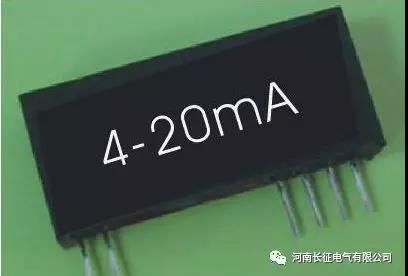Why use 4~20mA current to transmit analog?
Article From:HENAN CHANGZHENG ELECTRIC CO., LTD

The reason for using the current signal is not easy to be interfered with, because the amplitude of the noise voltage of the industrial site may reach several V, but the power of the noise is very weak, so the noise current is usually less than the nA level, so the error brought by 4-20mA transmission is very small; The internal resistance of the current source tends to infinity, and the wire resistance in series does not affect the accuracy in the loop, so it can be transmitted for hundreds of meters on the ordinary twisted pair. Due to the large internal resistance and constant current output of the current source, we only need to place a 250 ohm to the ground resistance at the receiving end to obtain 0-5V voltage, the advantage of the receiver with low input impedance is that the input current noise of nA level only produces very weak voltage noise.
The upper limit is 20mA because of the explosion-proof requirement: the spark energy caused by a 20mA electrical current break is not enough to ignite the gas. The reason why the lower limit is not 0mA is to detect the broken line: it will not be lower than 4mA in normal operation, and when the transmission line is broken due to a fault, the loop current drops to 0. 2mA is usually taken as the alarm value of broken line. The current type transmitter converts the physical quantity into 4~20mA current output, which must have an external power supply for its power supply. The most typical is that the transmitter needs two power lines, plus two current output lines, a total of 4 lines to connect, called a four-wire transmitter. Of course, the current output can be shared with the power supply by a wire (common VCC or GND), which can save a wire, so the four-wire transmitter is now basically called a three-wire transmitter. In fact, you may notice that the 4-20mA current itself can supply power to the transmitter, the transmitter is equivalent to a special load in the circuit, this transmitter only needs to be connected to 2 external wires, so it is called a two-wire transmitter. The lower limit of the industrial current loop standard is 4mA, so in the range, the transmitter is usually only 24V, 4mA power supply (therefore, high efficiency DC/DC power supply under light load conditions (TPS54331,TPS54160), Low-power sensor and signal chain products, as well as low-power processors (such as the MSP430) are important for two-wire 4-20mA transceivers. This makes the design of two-wire sensors both possible and challenging.
Generally need to design a VI converter, input 0-3.3v, output 4mA-20mA, can use the operation amplifier LM358, power supply +12v.
Related Products
-
VCZ-40.5GDseries indoor solid sealed high voltage vacuum circuit breaker
-
CZFZRN-40.5GD load switch fuse combination electrical apparatus
-
VCZ-40.5P series indoor high voltage solid sealed vacuum circuit breaker
-
ZN85-40.5 Indoor High Voltage Vacuum Circuit Breaker
-
VCZ-40.5GDseries indoor solid sealed high voltage vacuum circuit breaker
-
VCZ-12P with temperature measuring device series indoor high voltage vacuum circuit breaker
-
VCZ-12P series indoor solid sealed high voltage vacuum circuit breaker
-
VCZ-12P series indoor solid sealed high voltage vacuum circuit breaker
